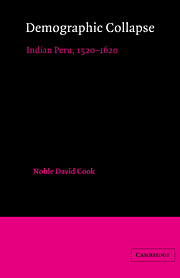Book contents
- Frontmatter
- Contents
- List of tables, figures, and maps
- Preface
- Introduction: The problem in perspective
- Part I Peru's preconquest population
- Part II Demographic collapse
- 8 First contact: north coast
- 9 Center of Spanish control: middle coast
- 10 Disease, earthquakes, and droughts: south coast
- 11 Intermediate area: northern highlands
- 12 Mining and population in the central sierra
- 13 The Indian heartland: southern highlands
- 14 An overview
- Abbreviations used in notes
- Notes
- Bibliography
- Index
- Titles in the series
10 - Disease, earthquakes, and droughts: south coast
Published online by Cambridge University Press: 02 December 2009
- Frontmatter
- Contents
- List of tables, figures, and maps
- Preface
- Introduction: The problem in perspective
- Part I Peru's preconquest population
- Part II Demographic collapse
- 8 First contact: north coast
- 9 Center of Spanish control: middle coast
- 10 Disease, earthquakes, and droughts: south coast
- 11 Intermediate area: northern highlands
- 12 Mining and population in the central sierra
- 13 The Indian heartland: southern highlands
- 14 An overview
- Abbreviations used in notes
- Notes
- Bibliography
- Index
- Titles in the series
Summary
The central Peruvian desert coast extends southward through several valley systems. The major rivers that descend to the Pacific and break the desert are the Pativilca, Huaura, Chancay, Rimac and Chillón, Malay, Cañete, Chincha, Pisco, lea, and Nazca. At the time of the conquest, most residents of the central coast subsisted on the basis of irrigation agriculture, with food supplemented by marine resources. Most of the area was brought into the Inca Empire through conquests between 1460 and 1480. Pachacamac was the most important center in that sector of the Peruvian coastal region.
Excerpt from the Arequipa town meeting, in Victor M. Barriga (ed.), Los terremotos en Arequipa, pp. 55–6As one continues down the Peruvian coast, the desert becomes more pronounced and the river valleys fewer and farther between. Less rainfall descends on the western slopes of the Andes as the Chilean border is approached. Scarce water results in little land under cultivation and a small population. Even in pre-Spanish times the south coastal population was lower than in the other coastal sectors. Another negative factor affecting population of the area is geological instability. A series of volcanos extend from roughly 150 kilometers northwest of Arequipa to 100 kilometers southeast of the city. There are frequent and severe seismic movements in the region, and these have historically limited the rate of development of the afflicted area.
- Type
- Chapter
- Information
- Demographic CollapseIndian Peru, 1520–1620, pp. 165 - 177Publisher: Cambridge University PressPrint publication year: 1982



